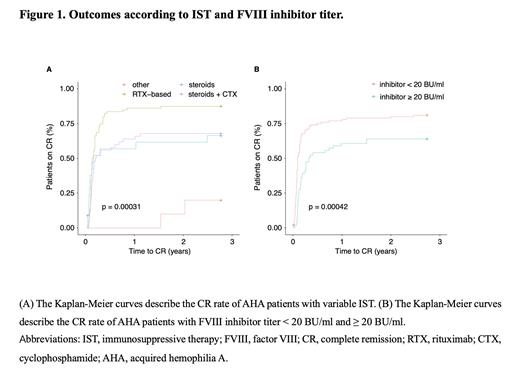Introduction and aim:
Acquired hemophilia A (AHA) is a rare hemorrhagic disorder caused by the existence of factor VIII (FVIII) inhibitors with an estimated annual incidence of 1.5 per million people. AHA patients are characterized by exceeding bleeding of varying severity, while approximately 10% of AHA patients have no bleeding symptoms. It's a challenge to diagnose and manage AHA due to its rarity and heterogeneity. We conducted a retrospective study to report the characteristics and outcomes of AHA and enhance its recognition and management.
Methods:
Patients diagnosed and treated with AHA at the Blood Disease Hospital, Chinese Academy of Medical Sciences between July 1997 to December 2021 were retrospectively enrolled. Demographics, clinical characteristics, treatments, and outcomes were collected. All Patients were followed immediately from admission to our center and ended in March 2022. Bleeding severity was assessed retrospectively in March 2022 by bleeding score (BS), a summary score aggregated by the International Society on Thrombosis and Hemostasis/ Scientific and Standardization Committee (ISTH/SSC) bleeding assessment tool (BAT) (2010 edition).
Results:
A total of 165 AHA patients admitted to our center were enrolled. The median age at diagnosis was 45 (10-90) years. Overall, a female preponderance (106/165, 64.2%) was observed in this cohort. Notable, the proportion of male patients increased with age.
Most patients (126/165, 76.4%) were idiopathic with no underlying diseases discovered. Of the 39 (23.6%) patients with associated diseases, 12 patients had autoimmune diseases, 16 patients had infections, eight patients had malignancies (all solid tumors) and three patients were secondary to pregnancy. All patients presented at least one bleeding episode. Subcutaneous bleeding was most common affecting 84.8% (140/165) of patients, while hemarthrosis was infrequent (n=11, 6.7%). The median time from bleeding to be diagnosed as AHA was delayed (30, 2-5650 days).
Anti-FVIII antibody titer and FVIII level showed no correlation. A significant difference in FVIII activity was observed between patients with anti-FVIII antibody titer < 20 BU/ml and ≥ 20 BU/ml. The BS varied among all patients ranging from 2 to 12 with a median of 4. A significant difference in BS was observed among the mild (FVIII: C > 5 IU/dl), moderate (1 IU/dl < FVIII: C ≤ 5 IU/dl), and severe (FVIII: C ≤ 1 IU/dl) AHA patients (p < 0.05). The same conclusion was also drawn between patients with low anti-FVIII antibody titer (< 20 BU/ml) and high antibody titer (≥ 20 BU/ml). BS was not correlated with APTT (r=0.-0.04, 95% CI (-0.19-0.12), p > 0.05).
Hemostatic treatment was applied to 129 (78.2%) AHA patients. Of the 163 patients who received immunosuppressive therapy (IST), 22 (13.5%) received steroids alone, with an 82.4% complete remission (CR) rate, 50 (30.7%) received steroids plus cyclophosphamide (CTX), with an 85.0% CR rate, 80 (49.1%) received rituximab-based therapy, which includes rituximab plus steroids, rituximab plus steroids and CTX, and rituximab plus steroids and other immunosuppressants, with a 93.3% CR rate (Figure 1A). There were seven deaths. Causes of death were bleeding (n=3), underlying disease (n=1), pulmonary infection (m=1), and unknown (n=2).
FVIII inhibitor titer ≥ 20 BU/ml was the only significant poor prognostic factor for CR (HR 0.56; 95% CI, 0.37-0.85; p < 0.01). In addition, patients with FVIII inhibitor titers ≥ 20 BU/ml needed more time to achieve CR (130 days vs. 35 days; p < 0.01) and showed a lower CR rate (77.6% vs. 94.9%, p < 0.01) than those with FVIII inhibitor titers < 20 BU/ml (Figure 1B).
Conclusions:
Delayed diagnosis of AHA patients is a severe issue. The rituximab-based regimen is more likely to achieve a CR in AHA patients. The only poor predictor of CR for AHA patients was FVIII inhibitor titer ≥ 20 BU/ml.
Disclosures
No relevant conflicts of interest to declare.


